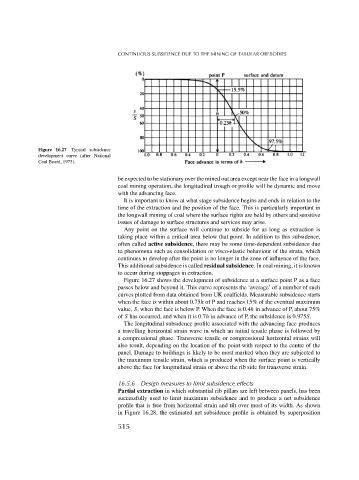Page 533 - Rock Mechanics For Underground Mining
P. 533
CONTINUOUS SUBSIDENCE DUE TO THE MINING OF TABULAR OREBODIES
Figure 16.27 Typical subsidence
development curve (after National
Coal Board, 1975).
be expected to be stationary over the mined out area except near the face in a longwall
coal mining operation, the longitudinal trough or profile will be dynamic and move
with the advancing face.
It is important to know at what stage subsidence begins and ends in relation to the
time of the extraction and the position of the face. This is particularly important in
the longwall mining of coal where the surface rights are held by others and sensitive
issues of damage to surface structures and services may arise.
Any point on the surface will continue to subside for as long as extraction is
taking place within a critical area below that point. In addition to this subsidence,
often called active subsidence, there may be some time-dependent subsidence due
to phenomena such as consolidation or visco-elastic behaviour of the strata, which
continues to develop after the point is no longer in the zone of influence of the face.
This additional subsidence is called residual subsidence. In coal mining, it is known
to occur during stoppages in extraction.
Figure 16.27 shows the development of subsidence at a surface point P as a face
passes below and beyond it. This curve represents the ‘average’ of a number of such
curves plotted from data obtained from UK coalfields. Measurable subsidence starts
when the face is within about 0.75h of P and reaches 15% of the eventual maximum
value, S, when the face is below P. When the face is 0.4h in advance of P, about 75%
of S has occurred, and when it is 0.7h in advance of P, the subsidence is 0.975S.
The longitudinal subsidence profile associated with the advancing face produces
a travelling horizontal strain wave in which an initial tensile phase is followed by
a compressional phase. Transverse tensile or compressional horizontal strains will
also result, depending on the location of the point with respect to the centre of the
panel. Damage to buildings is likely to be most marked when they are subjected to
the maximum tensile strain, which is produced when the surface point is vertically
above the face for longitudinal strain or above the rib side for transverse strain.
16.5.6 Design measures to limit subsidence effects
Partial extraction in which substantial rib pillars are left between panels, has been
successfully used to limit maximum subsidence and to produce a net subsidence
profile that is free from horizontal strain and tilt over most of its width. As shown
in Figure 16.28, the estimated net subsidence profile is obtained by superposition
515

